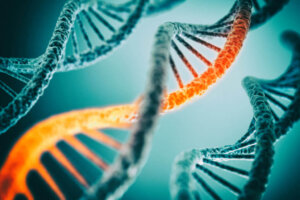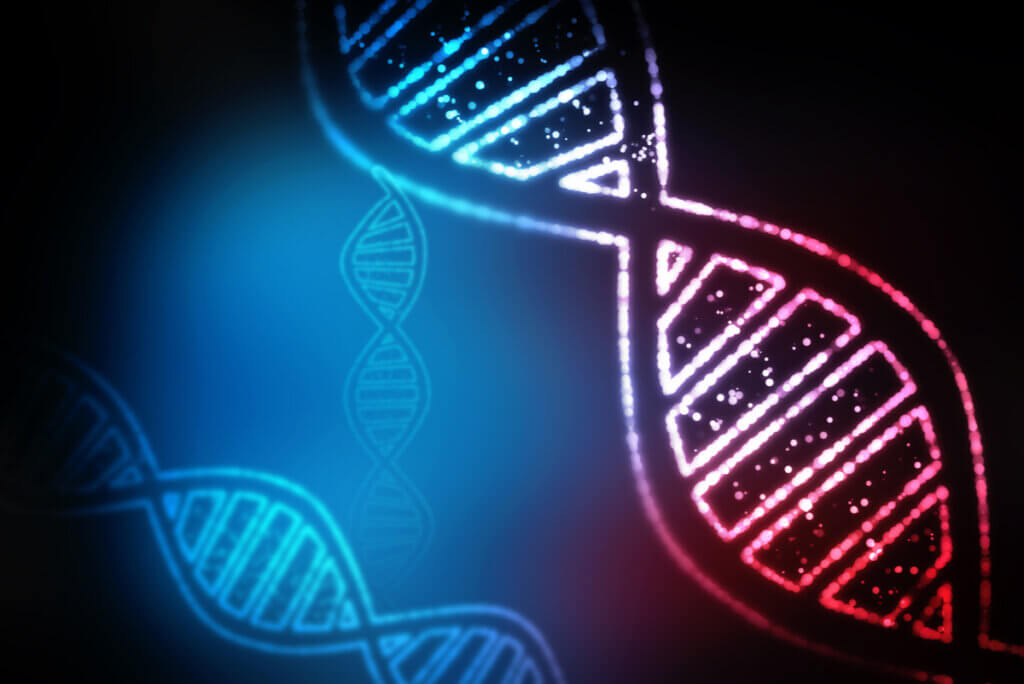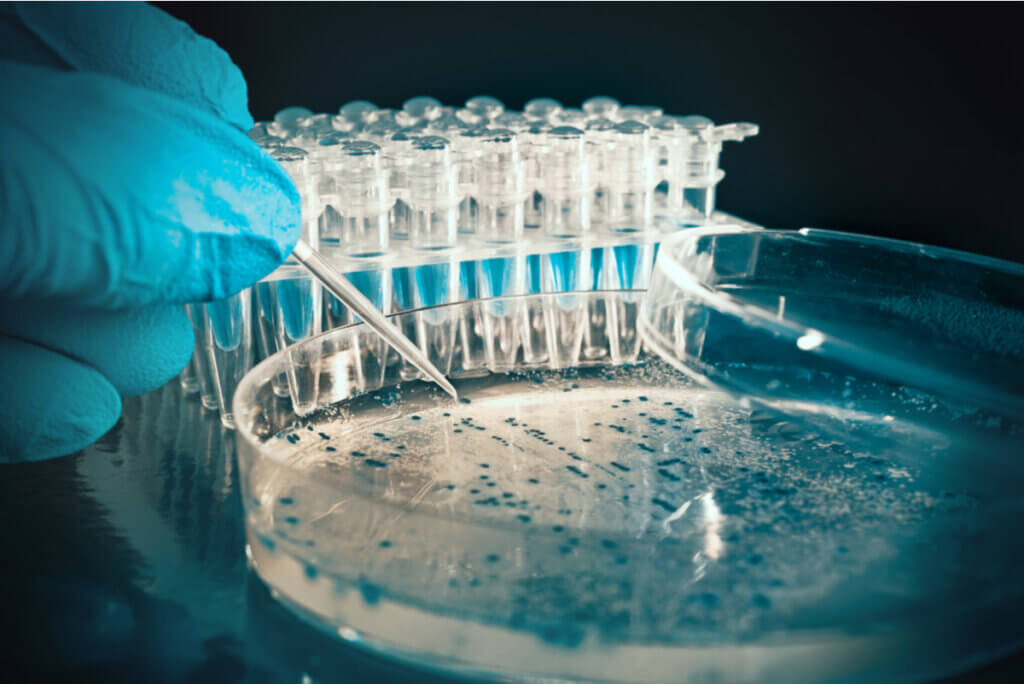Molecular Biology: What Does This Discipline Consist Of?


Escrito y verificado por el biólogo Samuel Antonio Sánchez Amador
Molecular biology is a scientific discipline within biology that’s responsible for studying the processes that take place in living beings from a molecular point of view. That is, the smallest part of a chemical substance that retains its properties.
The Human Genome Project, launched to map all the genes of our species, provides the following definition of molecular biology: “The study of the structure, function, and composition of biologically important molecules.”
It’s about molecules. We enter a world unknown to many, filled with exciting terms that make up its foundations, and, in most cases, abstract concepts that are invisible to the human eye.
The two macromolecules of life
According to the journal Nature, molecular biology, more than a tool, is an approach, one whose goal is to search beyond the observable biological manifestations on a large scale. To do this, molecular biologists rely on the study of two essential macromolecules. We’ll tell you below.
DNA
DNA or deoxyribonucleic acid is the macromolecule of life because it contains the genetic instructions used in the development and growth of all living organisms. It’s also responsible for the hereditary transmission or, in other words, the evolution of the species over time.
We can see DNA as a kind of “library”, as within it, the nucleotides are associated in a certain order. These subunits, joined by phosphodiester bonds, give rise to the individual DNA strand. This chain, intertwined with another in an antiparallel way, forms the double helix.
In turn, each nucleotide contains a nitrogenous base that gives it its name. These can be the following: Adenine (A), guanine (G), cytosine (C) and, in the case of DNA, thymine (T). The order of the nitrogenous bases in the DNA chain generates different “sentences”, those that code for the proteins that give rise to the structure and function of organisms.

Proteins
Now we’ll change the focus a bit, as the second macromolecule on which molecular biology is based is protein. Proteins are made up of amino acids, which are encoded in the “sentences” that are formed every three base pairs of DNA. Let’s give an example:
CCA→ cytosine (C), cytosine (C), adenine (A)→ Proline
Therefore, a segment of DNA with the nucleotides arranged in a CCA manner will code for the synthesis of the amino acid proline. Through transcription and translation —processes that are beyond the purview of this space— RNA allows DNA instructions to be transported to ribosomes, where proteins are assembled.
Therefore, proteins are polymers formed by an association of amino acids in a specific order. Their function is structural, bioregulatory, and immune defense. As an interesting fact, we’ll say that proteins represent around 50% of the dry weight of most of our tissues.
Allied scientific disciplines
We’ve already described the two main study molecules of molecular genetics, but what other disciplines accompany it in the search for knowledge? We’ll show you.
Biochemistry
Biochemistry is a branch of science that studies the chemical composition of living beings, especially proteins, carbohydrates, lipids, and nucleic acids. Unlike molecular biology, it focuses more on the metabolic processes that these compounds undergo in the bodies of living beings.
An example of this would be the description of the synthesis of glucose from glycogen. This science is responsible for investigating the enzymes involved in this process and all the intermediate products that make the complete reaction possible. So to speak, it “maps” the metabolism of living beings.
Genetics
When DNA is involved in the study of any scientific field, genetics is required. The discipline attempts to understand how biological inheritance is transmitted from generation to generation through DNA. It attempts to predict how mutations, individual genes, and their interactions affect the phenotype of living things.
Characteristics of molecular biology
We’ve already described the two study macromolecules and the two accompanying branches of science that help molecular biology to obtain the knowledge on which it’s based. Even so, we still have to frame in a more tangible way what professionals really do in this matter. Let’s see some examples:
- Investigate along with genetics: The structure, function, and regulation exerted by genes on the body.
- Study the structures: Of the cellular corpuscles and their functions within each cell type: Mitochondria, nucleus, ribosomes, and others.
- Investigate along with biochemistry: The kinetics and composition of enzymes.
- Study the detailed composition of certain molecules: In different species of living beings. Knowledge that supports the branch of phylogenetics.
- Explain the biological behavior of macromolecules inside the cell: Therefore, describe the physiological functions of a living being based on this molecular knowledge.
This young science, coined as an official scientific discipline in the 1930s, is in expansion and continuous growth. New research methods increasingly allow us to describe underlying processes invisible to the human eye. Of course, the work of molecular biology has only just begun.
The main techniques of molecular biology
We’ve laid the foundations, but we have to go into the practicalities It’s time to launch into the field of techniques and tools that make it possible to obtain all this knowledge. Below, we’ll present the main techniques used by molecular biology.
1. Electrophoresis
According to the National Human Genome Research Institute (NIH), electrophoresis is defined as a technique used in the laboratory to separate DNA, RNA, or proteins based on their size and electrical charge.
Most molecules are electrically charged and, therefore, move in an electric field at a certain speed. By applying an electric current to these samples, placed on a paper or a gel, a clear separation is produced. The smaller molecules move faster through the medium to the pole that attracts them, while the larger ones stay behind.
This difference in speed through the porosity of the gel or paper allows scientists to observe a series of bands in the medium that provide relevant information. For example, you can find out the size of unknown DNA segments if you have a previous banding pattern.
2. PCR
This is the queen of techniques. Known as the polymerase chain reaction, PCR allows researchers to amplify very small fragments of DNA. That is, make a large number of copies of a specific segment in a short time.
This can help, for example, to diagnose a disease. If the genetic material of a virus is found in a sample from a patient, when it’s amplified, it can be detected much easier by other subsequent techniques.
3. Alteration of genetic properties
Surprising as it may seem, molecular biology has allowed humans to introduce new genes into cells of organisms that wouldn’t have them. This, for example, allows researchers to learn how the expression of a gene affects the organism or to create a protein factory, which is encoded by the introduced gene.
This is the case of insulin, as the gene that codified it was introduced in humans in a strain of E. coli and, from there, mass production of the hormone could be carried out for diabetic people, thanks to these modified bacteria.

Some practical applications of molecular biology
To finalize this tour of molecular biology, we’ll discuss some practical applications in various industries for human use. The company IBIAN Technologies shows us the benefits of this science in a clear and concise way. Here are some examples:
- The creation of transgenic plants: Those that can be resistant to certain diseases, show greater adaptability to harsh environments, or have enhanced nutritional value.
- Accelerated growth: Of some species of agricultural interest.
- Genetic improvements in bacterial strains: Making them synthesize amino acids, vitamins, vaccines, and a large number of compounds for human use.
- The production of drugs: Drugs that are more effective and, in turn, have fewer adverse effects.
As we can see, the knowledge of molecular biology goes beyond the theoretical. Knowing the biological behavior of molecules within cells has allowed humans to modify some key processes in various living beings, which translates into medical and economic benefits.
The future is in the hands of science
As we’ve aimed to express in this article, it’s clear to us that molecular biology, along with many other scientific disciplines, is the future of science. Through the study of DNA, proteins, and other molecules, this branch of biology has led and will lead to many key advances for the improvement of modern society.
The most relevant concept of all the above is the following: Molecular biology is an approach that aims to describe the physiological processes of living beings based on the molecules that form them. From here, the sky is the limit or, in this case, the genome itself.
Molecular biology is a scientific discipline within biology that’s responsible for studying the processes that take place in living beings from a molecular point of view. That is, the smallest part of a chemical substance that retains its properties.
The Human Genome Project, launched to map all the genes of our species, provides the following definition of molecular biology: “The study of the structure, function, and composition of biologically important molecules.”
It’s about molecules. We enter a world unknown to many, filled with exciting terms that make up its foundations, and, in most cases, abstract concepts that are invisible to the human eye.
The two macromolecules of life
According to the journal Nature, molecular biology, more than a tool, is an approach, one whose goal is to search beyond the observable biological manifestations on a large scale. To do this, molecular biologists rely on the study of two essential macromolecules. We’ll tell you below.
DNA
DNA or deoxyribonucleic acid is the macromolecule of life because it contains the genetic instructions used in the development and growth of all living organisms. It’s also responsible for the hereditary transmission or, in other words, the evolution of the species over time.
We can see DNA as a kind of “library”, as within it, the nucleotides are associated in a certain order. These subunits, joined by phosphodiester bonds, give rise to the individual DNA strand. This chain, intertwined with another in an antiparallel way, forms the double helix.
In turn, each nucleotide contains a nitrogenous base that gives it its name. These can be the following: Adenine (A), guanine (G), cytosine (C) and, in the case of DNA, thymine (T). The order of the nitrogenous bases in the DNA chain generates different “sentences”, those that code for the proteins that give rise to the structure and function of organisms.

Proteins
Now we’ll change the focus a bit, as the second macromolecule on which molecular biology is based is protein. Proteins are made up of amino acids, which are encoded in the “sentences” that are formed every three base pairs of DNA. Let’s give an example:
CCA→ cytosine (C), cytosine (C), adenine (A)→ Proline
Therefore, a segment of DNA with the nucleotides arranged in a CCA manner will code for the synthesis of the amino acid proline. Through transcription and translation —processes that are beyond the purview of this space— RNA allows DNA instructions to be transported to ribosomes, where proteins are assembled.
Therefore, proteins are polymers formed by an association of amino acids in a specific order. Their function is structural, bioregulatory, and immune defense. As an interesting fact, we’ll say that proteins represent around 50% of the dry weight of most of our tissues.
Allied scientific disciplines
We’ve already described the two main study molecules of molecular genetics, but what other disciplines accompany it in the search for knowledge? We’ll show you.
Biochemistry
Biochemistry is a branch of science that studies the chemical composition of living beings, especially proteins, carbohydrates, lipids, and nucleic acids. Unlike molecular biology, it focuses more on the metabolic processes that these compounds undergo in the bodies of living beings.
An example of this would be the description of the synthesis of glucose from glycogen. This science is responsible for investigating the enzymes involved in this process and all the intermediate products that make the complete reaction possible. So to speak, it “maps” the metabolism of living beings.
Genetics
When DNA is involved in the study of any scientific field, genetics is required. The discipline attempts to understand how biological inheritance is transmitted from generation to generation through DNA. It attempts to predict how mutations, individual genes, and their interactions affect the phenotype of living things.
Characteristics of molecular biology
We’ve already described the two study macromolecules and the two accompanying branches of science that help molecular biology to obtain the knowledge on which it’s based. Even so, we still have to frame in a more tangible way what professionals really do in this matter. Let’s see some examples:
- Investigate along with genetics: The structure, function, and regulation exerted by genes on the body.
- Study the structures: Of the cellular corpuscles and their functions within each cell type: Mitochondria, nucleus, ribosomes, and others.
- Investigate along with biochemistry: The kinetics and composition of enzymes.
- Study the detailed composition of certain molecules: In different species of living beings. Knowledge that supports the branch of phylogenetics.
- Explain the biological behavior of macromolecules inside the cell: Therefore, describe the physiological functions of a living being based on this molecular knowledge.
This young science, coined as an official scientific discipline in the 1930s, is in expansion and continuous growth. New research methods increasingly allow us to describe underlying processes invisible to the human eye. Of course, the work of molecular biology has only just begun.
The main techniques of molecular biology
We’ve laid the foundations, but we have to go into the practicalities It’s time to launch into the field of techniques and tools that make it possible to obtain all this knowledge. Below, we’ll present the main techniques used by molecular biology.
1. Electrophoresis
According to the National Human Genome Research Institute (NIH), electrophoresis is defined as a technique used in the laboratory to separate DNA, RNA, or proteins based on their size and electrical charge.
Most molecules are electrically charged and, therefore, move in an electric field at a certain speed. By applying an electric current to these samples, placed on a paper or a gel, a clear separation is produced. The smaller molecules move faster through the medium to the pole that attracts them, while the larger ones stay behind.
This difference in speed through the porosity of the gel or paper allows scientists to observe a series of bands in the medium that provide relevant information. For example, you can find out the size of unknown DNA segments if you have a previous banding pattern.
2. PCR
This is the queen of techniques. Known as the polymerase chain reaction, PCR allows researchers to amplify very small fragments of DNA. That is, make a large number of copies of a specific segment in a short time.
This can help, for example, to diagnose a disease. If the genetic material of a virus is found in a sample from a patient, when it’s amplified, it can be detected much easier by other subsequent techniques.
3. Alteration of genetic properties
Surprising as it may seem, molecular biology has allowed humans to introduce new genes into cells of organisms that wouldn’t have them. This, for example, allows researchers to learn how the expression of a gene affects the organism or to create a protein factory, which is encoded by the introduced gene.
This is the case of insulin, as the gene that codified it was introduced in humans in a strain of E. coli and, from there, mass production of the hormone could be carried out for diabetic people, thanks to these modified bacteria.

Some practical applications of molecular biology
To finalize this tour of molecular biology, we’ll discuss some practical applications in various industries for human use. The company IBIAN Technologies shows us the benefits of this science in a clear and concise way. Here are some examples:
- The creation of transgenic plants: Those that can be resistant to certain diseases, show greater adaptability to harsh environments, or have enhanced nutritional value.
- Accelerated growth: Of some species of agricultural interest.
- Genetic improvements in bacterial strains: Making them synthesize amino acids, vitamins, vaccines, and a large number of compounds for human use.
- The production of drugs: Drugs that are more effective and, in turn, have fewer adverse effects.
As we can see, the knowledge of molecular biology goes beyond the theoretical. Knowing the biological behavior of molecules within cells has allowed humans to modify some key processes in various living beings, which translates into medical and economic benefits.
The future is in the hands of science
As we’ve aimed to express in this article, it’s clear to us that molecular biology, along with many other scientific disciplines, is the future of science. Through the study of DNA, proteins, and other molecules, this branch of biology has led and will lead to many key advances for the improvement of modern society.
The most relevant concept of all the above is the following: Molecular biology is an approach that aims to describe the physiological processes of living beings based on the molecules that form them. From here, the sky is the limit or, in this case, the genome itself.
- Definición de biología Molecular, Human Genome Project National Archieve 1990-2003. Recogido a 9 de noviembre en https://web.ornl.gov/sci/techresources/Human_Genome/redirect.shtml
- Astbury WT (June 1961). “Molecular biology or ultrastructural biology?”. Nature. 190 (4781): 1124.
- Electroforesis (NIH): Recogido a 9 de noviembre en https://www.genome.gov/es/genetics-glossary/Electroforesis
- Biología molecular: usos para cada sector. IBIAN technologies. Recogido a 9 de noviembre en https://www.ibiantech.com/biologia-molecular-usos-sector/
- Davis, Leonard. Basic methods in molecular biology. Elsevier, 2012.
- Morange, Michel. A history of molecular biology. Harvard University Press, 2000.
Este texto se ofrece únicamente con propósitos informativos y no reemplaza la consulta con un profesional. Ante dudas, consulta a tu especialista.







